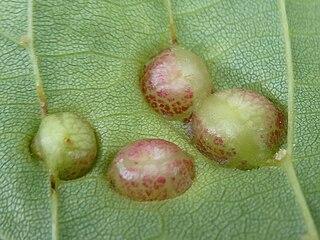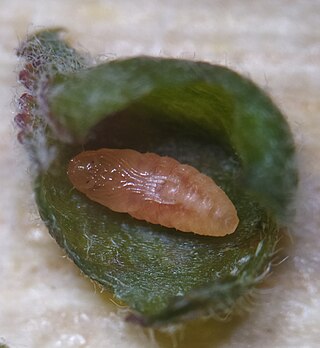
A midge is any small fly, including species in several families of non-mosquito nematoceran Diptera. Midges are found on practically every land area outside permanently arid deserts and the frigid zones. Some midges, such as many Phlebotominae and Simuliidae, are vectors of various diseases. Many others play useful roles as prey for insectivores, such as various frogs and swallows. Others are important as detritivores, and form part of various nutrient cycles. The habits of midges vary greatly from species to species, though within any particular family, midges commonly have similar ecological roles.

Cecidomyiidae is a family of flies known as gall midges or gall gnats. As the name implies, the larvae of most gall midges feed within plant tissue, creating abnormal plant growths called galls. Cecidomyiidae are very fragile small insects usually only 2–3 mm (0.079–0.118 in) in length; many are less than 1 mm (0.039 in) long. They are characterised by hairy wings, unusual in the order Diptera, and have long antennae. Some Cecidomyiids are also known for the strange phenomenon of paedogenesis in which the larval stage reproduces without maturing first. In some species, the daughter larvae consume the mother, while in others, reproduction occurs later on in the egg or pupa.

A gnat is any of many species of tiny flying insects in the dipterid suborder Nematocera, especially those in the families Mycetophilidae, Anisopodidae and Sciaridae. Most often they fly in large numbers, called clouds. "Gnat" is a loose descriptive category rather than a phylogenetic or other technical term, so there is no scientific consensus on what constitutes a gnat. Some entomologists consider only non-biting flies to be gnats. Certain universities and institutes also distinguish eye gnats: the Smithsonian Institution describes them as "non-biting flies, no bigger than a few grains of salt, ... attracted to fluids secreted by your eyes".
Neolasioptera allioniae is a species of gall midges, insects in the family Cecidomyiidae. It forms galls in Allionia (Nyctaginaceae), possibly also other species in the family including Mirabilis nyctaginea. It occurs in the United States of America from Colorado to Texas, possibly more widely.

Contarinia verrucicola, known generally as the linden wart gall midge, is a species of gall midges in the family Cecidomyiidae.

Cecidomyiini is a tribe of gall midges in the family Cecidomyiidae. There are at least 220 described species in Cecidomyiini.

Taxodiomyia is a genus of cypress gall midges, insects in the family Cecidomyiidae. There are at least 3 described species in Taxodiomyia.

Asphondyliini is a tribe of gall midges in the family Cecidomyiidae. There are about six genera and at least 100 described species in Asphondyliini.
Asphondylia websteri, the alfalfa gall midge, is a species of gall midges in the family Cecidomyiidae.

Caryomyia caryaecola, the hickory onion gall midge, is a species of gall midges in the family Cecidomyiidae.

Caryomyia is a genus of hickory gall midges in the family Cecidomyiidae. They are often known as the hickory gall midges since most species feed on various species of hickory. There are at least 30 described species in Caryomyia.
Caryomyia sanguinolenta, also known as hickory smooth gumdrop gall midge, is a species of gall midge in the family Cecidomyiidae.

Rhopalomyia pedicellata is a species of gall midges, insects in the family Cecidomyiidae.

Rhopalomyia is a genus of gall midges, insects in the family Cecidomyiidae. There are at least 267 described species in Rhopalomyia. Most species in this genus induce galls on plants in the Asteraceae. This genus has a cosmopolitan distribution. Rhopalomyia was first established by Ewald Heinrich Rübsaamen in 1892.

Oligotrophini is a tribe of gall midges, insects in the family Cecidomyiidae. There are at least 300 described species in Oligotrophini.
Neolasioptera is a genus of gall midges, insects in the family Cecidomyiidae. There are at least 130 described species in Neolasioptera.

Dasineura carbonaria is a species of gall midges in the family Cecidomyiidae. It forms galls on Euthamia graminifolia.

Dasineura gleditchiae, commonly known as the honeylocust podgall midge, is a species of gall midge in the family Cecidomyiidae. Native to North America, it is an invasive species in parts of Europe. The honeylocust podgall midge is a pest of honey locust, forming galls on the foliage.

Taxodiomyia cupressiananassa, commonly known as the cypress twig gall midge, is a species of gall midge in the family Cecidomyiidae.












